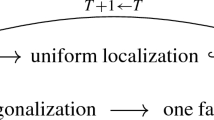Abstract
This paper studies a classical infinite horizon optimal control problem for a shallow lake model and a variation thereof. We carry out a qualitative analysis of solutions to the canonical system and identify possible scenarios. Specifically, we describe a particular case that has not been addressed in the previous works. This case corresponds to the situation, when the canonical system has only two saddle equilibrium points without a source between them. Furthermore, the set of parameters, for which this situation occurs remains unchanged for two alternative formulations of the optimal control problem, which indicates a possibility for a hidden invariant structure. Both formulations of the optimal control problem are studied in detail, both analytically and numerically. The appearance of the Skiba point is discussed.
A part of this study was carried out while the first author was with the Faculty of Applied Mathematics and Control Processes, St. Petersburg State University.
Access this chapter
Tax calculation will be finalised at checkout
Purchases are for personal use only
Similar content being viewed by others
References
Agliari, A., Vachadze, G.: Homoclinic and heteroclinic bifurcations in an overlapping generations model with credit market imperfection. Comput. Econ. 38(3), 241–260 (2011). https://doi.org/10.1007/s10614-011-9282-y
Bikker, P., Uteshev, A.Y.: On the Bézout construction of the resultant. J. Symb. Comput. 28(1–2), 45–88 (1999). https://doi.org/10.1006/jsco.1999.0267
Brock, W.A., Starrett, D.: Managing systems with non-convex positive feedback. Environ. Res. Econ. 26(4), 575–602 (2003). https://doi.org/10.1023/B:EARE.0000007350.11040.e3
Caulkins, J.P., Feichtinger, G., Grass, D., Hartl, R.F., Kort, P.M., Seidl, A.: Skiba points in free end-time problems. J. Econ. Dyn. Control 51, 404–419 (2015). https://doi.org/10.1016/j.jedc.2014.11.003
Grass, D., Caulkins, J.P., Feichtinger, G., Tragler, G., Behrens, D.A.: Optimal control of nonlinear processes: With Applications in Drugs, Corruption, and Terror. Springer, Heidelberg (2008). https://doi.org/10.1007/978-3-540-77647-5
Gromov, D., Castanos, F.: Sensitivity analysis of limit cycles in an alpha Stirling engine: a bifurcation-theory approach. SIAM J. Appl. Dyn. Syst. 19(3), 1865–1883 (2020). https://doi.org/10.1137/19M1299293
Gromov, D., Upmann, T.: Dynamics and economics of shallow lakes: a survey. Sustainability 13(24) (2021). https://doi.org/10.3390/su132413763
Heijnen, P., Wagener, F.O.O.: Avoiding an ecological regime shift is sound economic policy. J. Econ. Dyn. Control 37(7), 1322–1341 (2013). https://doi.org/10.1016/j.jedc.2013.03.003
Janmaat, J.A.: Fishing in a shallow lake: exploring a classic fishery model in a habitat with shallow lake dynamics. Environ. Res. Econ. 51(2), 215–239 (2012). https://doi.org/10.1007/s10640-011-9495-5
Kiseleva, T., Wagener, F.O.: Bifurcations of optimal vector fields in the shallow lake model. J. Econ. Dyn. Control 34(5), 825–843 (2010). https://doi.org/10.1016/j.jedc.2009.11.008
Kuznetsov, Y.A.: Elements of Applied Bifurcation Theory. Springer, Heidelberg (1995). https://doi.org/10.1007/978-1-4757-3978-7
Mäler, K.G., Xepapadeas, A., De Zeeuw, A.: The economics of shallow lakes. Environ. Res. Econ. 26(4), 603–624 (2003). https://doi.org/10.1023/B:EARE.0000007351.99227.42
Pontryagin, L.S., Boltyanskii, V.G., Gamkrelidze, R.V., Mishchenko, E.F.: Mathematical Theory of Optimal Processes. CRC Press, Boca Raton (1987)
Qi-Chang, Z., Wei, W., Wei-Yi, L.: Heteroclinic bifurcation of strongly nonlinear oscillator. Chin. Phys. Lett. 25(5), 1905 (2008). https://doi.org/10.1088/0256-307X/25/5/105
Sethi, S.P.: Nearest feasible paths in optimal control problems: theory, examples, and counterexamples. J. Optim. Theory Appl. 23(4), 563–579 (1977). https://doi.org/10.1007/BF00933297
Skiba, A.K.: Optimal growth with a convex-concave production function. Econometrica: J. Econometric Soc., 527–539 (1978). https://doi.org/10.2307/1914229
Wagener, F.O.O.: Skiba points and heteroclinic bifurcations, with applications to the shallow lake system. J. Econ. Dyn. Control 27(9), 1533–1561 (2003). https://doi.org/10.1016/S0165-1889(02)00070-2
de Zeeuw, A.: Regime shifts in resource management. Ann. Rev. Res. Econ. 6(1), 85–104 (2014). https://doi.org/10.1146/annurev-resource-100913-012405
Acknowledgements
We thank Prof. A. Yu. Uteshev for valuable hints regarding the polynomial analysis. The reported study was funded by RFBR and DFG, project number 21-51-12007.
Author information
Authors and Affiliations
Corresponding author
Editor information
Editors and Affiliations
Rights and permissions
Copyright information
© 2022 The Author(s), under exclusive license to Springer Nature Switzerland AG
About this paper
Cite this paper
Gromov, D., Wu, Y. (2022). Qualitative Analysis of an Infinite Horizon Optimal Control Problem of a Shallow Lake. In: Olenev, N., Evtushenko, Y., Jaćimović, M., Khachay, M., Malkova, V., Pospelov, I. (eds) Optimization and Applications. OPTIMA 2022. Lecture Notes in Computer Science, vol 13781. Springer, Cham. https://doi.org/10.1007/978-3-031-22543-7_9
Download citation
DOI: https://doi.org/10.1007/978-3-031-22543-7_9
Published:
Publisher Name: Springer, Cham
Print ISBN: 978-3-031-22542-0
Online ISBN: 978-3-031-22543-7
eBook Packages: Computer ScienceComputer Science (R0)




